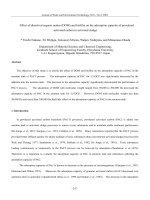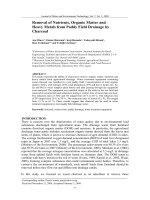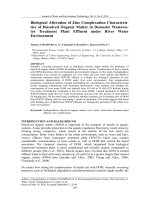Front matter
Bạn đang xem bản rút gọn của tài liệu. Xem và tải ngay bản đầy đủ của tài liệu tại đây (44.35 MB, 314 trang )
www.pdfgrip.com
Analytical Instrumentation
Analytical Instrumentation: A Guide to Laboratory, Portable and Miniaturized Instruments
© 2007 John Wiley & Sons, Ltd. ISBN: 978-0-470-02795-0
G. McMahon
www.pdfgrip.com
Analytical
Instrumentation
A Guide to Laboratory,
Portable and
Miniaturized Instruments
First Edition
GILLIAN MCMAHON
School of Chemical Sciences
Dublin City University
Ireland
www.pdfgrip.com
Copyright © 2007 John Wiley & Sons Ltd, The Atrium, Southern Gate, Chichester,
West Sussex PO19 8SQ, England
Telephone (ϩ44) 1243 779777
Email (for orders and customer service enquiries):
Visit our Home Page on www.wileyeurope.com or www.wiley.com
All Rights Reserved. No part of this publication may be reproduced, stored in a retrieval system or transmitted in any form
or by any means, electronic, mechanical, photocopying, recording, scanning or otherwise, except under the terms of the
Copyright, Designs and Patents Act 1988 or under the terms of a licence issued by the Copyright Licensing Agency Ltd, 90
Tottenham Court Road, London W1T 4LP, UK, without the permission in writing of the Publisher. Requests to the Publisher
should be addressed to the Permissions Department, John Wiley & Sons Ltd, The Atrium, Southern Gate, Chichester, West
Sussex PO19 8SQ, England, or emailed to , or faxed to (ϩ44) 1243 770620.
Designations used by companies to distinguish their products are often claimed as trademarks. All brand names and product
names used in this book are trade names, service marks, trademarks or registered trademarks of their respective owners.
The Publisher is not associated with any product or vendor mentioned in this book.
This publication is designed to provide accurate and authoritative information in regard to the subject matter covered. It
is sold on the understanding that the Publisher is not engaged in rendering professional services. If professional advice or
other expert assistance is required, the services of a competent professional should be sought.
The Publisher and the Author make no representations or warranties with respect to the accuracy or completeness of the
contents of this work and specifically disclaim all warranties, including without limitation any implied warranties of
fitness for a particular purpose. The advice and strategies contained herein may not be suitable for every situation. In view
of ongoing research, equipment modifications, changes in governmental regulations, and the constant flow of information
relating to the use of experimental reagents, equipment, and devices, the reader is urged to review and evaluate the
information provided in the package insert or instructions for each chemical, piece of equipment, reagent, or device for,
among other things, any changes in the instructions or indication of usage and for added warnings and precautions. The
fact that an organization or Website is referred to in this work as a citation and/or a potential source of further information
does not mean that the author or the publisher endorses the information the organization or Website may provide or
recommendations it may make. Further, readers should be aware that Internet Websites listed in this work may have
changed or disappeared between when this work was written and when it is read. No warranty may be created or extended
by any promotional statements for this work. Neither the Publisher nor the Author shall be liable for any damages arising
herefrom.
Other Wiley Editorial Offices
John Wiley & Sons Inc., 111 River Street, Hoboken, NJ 07030, USA
Jossey-Bass, 989 Market Street, San Francisco, CA 94103-1741, USA
Wiley-VCH Verlag GmbH, Boschstr. 12, D-69469 Weinheim, Germany
John Wiley & Sons Australia Ltd, 42 McDougall Street, Milton, Queensland 4064, Australia
John Wiley & Sons (Asia) Pte Ltd, 2 Clementi Loop #02-01, Jin Xing Distripark, Singapore 129809
John Wiley & Sons Ltd, 6045 Freemont Blvd, Mississauga, Ontario L5R 4J3, Canada
Wiley also publishes its books in a variety of electronic formats. Some content that appears in print may not be available in
electronic books.
Anniversary Logo Design: Richard J. Pacifico
British Library Cataloguing in Publication Data
A catalogue record for this book is available from the British Library
ISBN 978-0470-027950
Typeset in 10/12 pt Times by Thomson Digital
Printed and bound in Great Britain by Antony Rowe Ltd, Chippenham, Wiltshire, England
This book is printed on acid-free paper responsibly manufactured from sustainable forestry in which at least two trees are
planted for each one used for paper production.
www.pdfgrip.com
For Sophie and Charlie
www.pdfgrip.com
Contents
Page
Foreword
Preface
Acknowledgements
Acronyms and Abbreviations
xi
xiii
xv
xvii
1 Introduction
1.1 The Analytical Scientist
1.2 The Analytical Process
1.3 Analytical Instrumentation
1.4 Choosing the Right Instrument
Reference
1
1
2
3
4
6
SECTION I LABORATORY ANALYTICAL INSTRUMENTATION
7
2 Spectrometric Instruments
2.1 Molecular Spectrometry
2.1.1 Ultraviolet, Visible and Near Infrared
2.1.2 Infrared and Raman
2.1.3 Luminescence
2.1.4 Nuclear Magnetic Resonance
2.1.5 Mass Spectrometry
2.2 Atomic Spectrometry
2.2.1 Atomic Absorption Spectrometry and Atomic Fluorescence
Spectrometry
2.2.2 Inductively Coupled Plasma–Optical Emission Spectrometry
2.2.3 Inductively Coupled Plasma–Mass Spectrometry
References
3
Separation Instruments
3.1 Gas Chromatography
3.2 High Performance Liquid Chromatography
3.3 Ion Chromatography
3.4 Capillary Electrophoresis
3.5 Supercritical Fluid Chromatography
9
9
9
15
25
31
36
49
50
53
58
60
65
65
74
89
92
100
www.pdfgrip.com
viii
4
Contents
3.6 Hyphenated (Hybrid) Instruments
3.6.1 Hyphenated Gas Chromatography Techniques
3.6.2 Hyphenated Liquid Chromatography Techniques
3.6.3 Hyphenated Capillary Electrophoresis Techniques
References
103
104
108
120
122
Imaging Instruments
4.1 Optical Microscopy
4.2 Confocal Microscopy
4.3 Electron Microscopy
4.3.1 Scanning Electron Microscopy
4.3.2 Transmission Electron Microscopy
4.4 Scanning Probe Microscopy
4.4.1 Scanning Tunnelling Microscopy
4.4.2 Atomic Force Microscopy
4.5 Spectral Imaging
References
125
125
127
129
130
133
135
135
138
141
145
5 Electrochemical Instruments
5.1 Potentiometry
5.2 Voltammetry
5.3 Conductimetry
References
147
147
154
159
161
6 Other Instruments
6.1 Thermogravimetric Analysis
6.2 Differential Scanning Calorimetry
6.3 X-ray Diffraction
References
163
163
166
170
172
SECTION II
173
7
PORTABLE ANALYTICAL INSTRUMENTATION
The Drive for Portable Analytical Instruments
175
Portable Instruments in the Laboratory
7.1 Spectrometric Instruments
7.2 Separation Instruments
7.3 Imaging Instruments
7.4 Electrochemical Instruments
References
177
177
186
189
193
196
8 Portable Instruments in Various Applications
8.1 Medical Applications
8.1.1 Point-of-Care Technology
8.1.2 Blood Glucose Testing
8.1.3 Blood Coagulation Monitoring
8.1.4 Other Point-of-Care Devices
199
199
199
200
206
207
www.pdfgrip.com
Contents
8.2
Environmental Applications
8.2.1 Field Devices
8.2.2 Water Quality Monitoring
8.2.3 Soil and Sediment Testing
8.2.4 Air Monitoring
8.3 Security and Defence Applications
8.4 Other Applications
References
SECTION III
PROCESS ANALYTICAL INSTRUMENTATION
The Drive for Process Analysis
References
9 Process Analytical Instrumentation in Industry
9.1 In-Process Sampling
9.2 In-Process Analysis
9.2.1 Flow Injection Analysis
9.2.2 Spectroscopic Analysis
9.2.3 Separation Analysis
9.2.4 Imaging Analysis
9.2.5 Electrochemical Analysis
9.3 Laboratory Integrated Management Systems
References
SECTION IV MINIATURISED ANALYTICAL INSTRUMENTATION
ix
209
209
209
211
211
212
214
215
217
219
221
223
223
226
229
234
243
245
245
246
247
251
The Drive for Miniaturised Analytical Instrumentation
References
253
254
10 Chip-based Instrumentation
10.1 The Development of Chip-based Analytical Devices
10.2 Challenges for Chip-based Analytical Devices
10.2.1 Moving and Mixing Fluids on a Chip
10.2.2 Fitting Components onto a Chip
10.2.3 Sampling and Detection Strategies
10.2.4 Understanding Processes on the Microscale
10.3 Chip-based Analytical Instruments
10.3.1 Lab-on-valve Flow Injection Analysis
10.3.2 Spectroscopic Devices
10.3.3 Separation Devices
10.3.4 Imaging Devices
10.3.5 Electrochemical Devices
10.3.6 Other Chip-based Devices
References
255
255
256
256
259
263
264
264
264
266
268
272
273
274
276
Index
283
www.pdfgrip.com
Foreword
This book has arisen from a series of lectures developed by Dr Gillan McMahon and delivered to students on the taught postgraduate module on instrumentation at Dublin City
University. Gillian was previously herself a student in DCU and since graduating, she
has developed her analytical background initially in industry in the pharmachem arena,
and more recently, as a very successful academic teacher and researcher. She gained a
wealth of experience over a broad range of analytical techniques in the pharmachem
industry, working with the Geotest Chemical Company (USA), Newport Pharmaceuticals (Ireland), Bristol-Myers Squibb (Ireland) and Zeneca Pharmaceuticals (UK). This
experience applied not just to the use of techniques and methods, but also to data tracking and compliance, which is a critical aspect for this sector. While with BMS, she was
engaged in training of staff in advanced analytical techniques and compliance at other
sites in Italy and Puerto Rico prior to production campaigns.
Her academic career as an analytical scientist is equally impressive. She completed
her PhD research at the Lombardi Cancer Centre, Georgetown University, USA and currently is a lecturer at Dublin City University, where she teaches on the two national
flagship analytical courses (Analytical Science BSc and Instrumental Analysis MSc).
In addition to her impressive research publications, and activities in professional bodies
like the Royal Society of Chemistry and Institute of Chemistry of Ireland, Gillian has
also won significant external research funding, and has been the recipient of numerous
individual awards for dissemination.
Gillian therefore brings a rare, but vitally important mix of experience to this text. Analytical science is a complex discipline, ranging from instrumentation, electronics, optics,
through data processing and statistics, to the fundamental science of molecular recognition and transduction. Analytical techniques are employed in an every-increasing range
of applications. Along with synthetic chemistry, it provides the cornerstone of the pharmceutical industry. Without analytical information and new methods, the human genome
project would never have been realised, and high throughput bioanalytical instruments are
now helping to unravel the secrets of human genetic disposition to disease.
Analytical instruments are routinely used to monitor the status of our environment
and the quality of our food, and to enable individuals to track personal health indicators.
And of course, where would forensic science be without analytical instruments? Devising
a text to teach the principles and practice of analytical science to students with a wide
diversity of educational backgrounds requires a balance between depth and breadth, and
above all, a systematic, consistent approach. In this text, Gillian has met this formidable
challenge, and the result is a clearly written and structured text that reveals the basis of the
www.pdfgrip.com
xii
Foreword
key instrumental methods, and the importance they play in many aspects of modern life.
The clarity of the explanations will appeal to both undergraduate and postgraduate students, as well as scientists in industry and will help guide them in a practical way towards
particular specialisms they may find interesting as they move through their career.
The text breaks new ground in that it takes the reader all the way from large, lab-based
instruments through to on-line and in-line instruments for industry, to portable and handheld equipment and finally to micro-scale lab-on-a-chip devices. This offers an alternative
approach for teaching modern instrumentation. It covers a wide range of modern instrumental methods in a practical and relevant way, including techniques not traditionally
covered in analytical instrumentation texts, such as the imaging techniques which are becoming ubiquitous in modern analytical laboratories. Gillian’s background in compliance
comes through in the section covering on-line and in-line instruments wherein she covers
not only the sensing and analytical techniques used in process analysis, but also the new
FDA-driven phenomenon of process analytical technology (PAT).
Always appealing to students is the ability to make the technology and science relevant.
Gillian excels in this respect, linking analytical platforms to numerous specific examples of
applications ranging across healthcare, the environment and the pharmaceutical industry.
In conclusion, this is an exciting new resource for analytical science education that, I
have no doubt, will prove to be popular with students and educators alike. I will certainly
have a copy on my shelf!
Dermot Diamond
BSc, PhD (QUB), PGCE, MICI, MRSC, C.Chem.
Science Foundation Ireland Principle Investigator
in the ‘Adaptive Information Cluster’
www.pdfgrip.com
Preface
The idea for this book on analytical instrumentation came after I was given the task
of writing and delivering a new lecture course entitled ‘Instrumentation’. The course
comprised a module in a taught postgraduate Masters in Instrumental Analysis. When
I examined the overall course content, the background of the students and the aim of
the qualification, I realised that I wanted it to be more than an explanation of the theory
and practice of standard analytical instrumental techniques – something that is already a
formidable task on its own. I felt strongly that the course should mirror recent trends in
instrumentation such as the development of portable and point-of-care instruments, use of
field devices, the significant integration of analytical equipment into industrial processes
and the area of miniaturisation. And since the course is pitched mainly at professional
scientists working in industry, the emphasis, I felt, should lean towards the practical rather
than the theoretical side of such knowledge.
While preparing the module lectures, I found myself reading across many disciplines,
from chemistry to engineering, learning about a range of technologies from biology to
physics and browsing many different aisles in the library, from medicine to regulation.
And yet, there was no one textbook that I could find to help me teach the course as I felt it
should be taught. And so the seed was sown and the rest is history….
I have tried to take a logical approach in the book by moving from the discussion of large
instruments at the beginning of the book to small instruments at the end of the book. This
also means that the book moves from traditional equipment through modern technology
to instruments only described in the literature, and at the same time from commercially
available equipment to devices only at the research and development stage.
Chapter 1 is a short introduction to analytical instrumentation and the analytical process
in general. I also explain a little about my approach.
Section I covers the more conventional equipment available for analytical scientists.
I have used a unified means of illustrating the composition of instruments over the five
chapters in this section. This system describes each piece of equipment in terms of five
modules – source, sample, discriminator, detector and output device. I believe this system
allows for easily comparing and contrasting of instruments across the various categories,
as opposed to other texts where different instrument types are represented by different
schematic styles. Chapter 2 in this section describes the spectroscopic techniques of visible
and ultraviolet spectrophotometry, near infrared, mid-infrared and Raman spectrometry,
fluorescence and phosphorescence, nuclear magnetic resonance, mass spectrometry and,
finally, a section on atomic spectrometric techniques. I have used the aspirin molecule as
an example all the way through this section so that the spectral data obtained from each
www.pdfgrip.com
xiv
Preface
technique for a simple organic compound can be compared and contrasted easily. Chapter
3 discusses separation techniques such as the well-known gas and liquid chromatographies,
capillary electrophoresis and supercritical fluid chromatography. The latter part of Chapter
3 is devoted to hyphenated (hybrid) techniques since these are so important in today’s
laboratory where complex mixtures often need to be separated prior to identification and
quantitation and where these demands can be met in one run. I also explain some of the
challenges that have been overcome in coupling instruments together effectively. Chapter
4 outlines the imaging methods that are becoming so much more prevalent in analytical
science where single-atom resolution is now possible. Not only are these appliances useful
as stand-alone instruments but often they are linked to spectral devices to enable spectral
imaging, an even more powerful tool. Chapter 5 describes the electrochemical methods
of potentiometry, voltammetry and conductivity measurement. Chapter 6 briefly covers
thermoanalytical and diffraction methods.
Section II moves into the realm of smaller instruments with a discussion of why there
is a drive to make devices more portable, the use of portable instruments in the laboratory
(with plenty of commercially-available examples) and uses of portable devices in medical
and environmental applications. Special emphasis is placed on point-of-care meters for
blood glucose testing and coagulation monitoring as their technologies are based on
simple, rugged chemical tests. Portable instruments in environmental monitoring have
made field testing a reality.
Section III discusses process analytical instrumentation, which is a big growth area in
science, especially in the petrochemical, food and beverage and pharmaceutical industries.
Manufacturers have had to shift the analytical emphasis of their equipment from sensitive
to rugged and analytical scientists have had to think like and work with engineers in order
to install on-line and in-line assays. After discussing in-process sampling and in-process
analysis, a number of examples are given of instruments that are being used in process
analytics applications.
Section IV then tackles the most recent trend in analytical instrumentation, which is
miniaturisation and the drive to create lab-on-a-chip devices. In this section, I discuss the
development of chip-based technologies and the challenges associated with this such as
pumping fluids on the microscale, fitting components onto a chip, detection strategies and
how processes such as mixing are so different in the microworld when compared to the
macroworld.
As a final note, it is clear that analytical instrumentation is developing at a very fast
pace and getting smaller, smarter and faster every year. I hope that by reading some or
all of this book that the reader will have learned something new and found the journey
interesting along the way.
Gillian McMahon
www.pdfgrip.com
Acknowledgements
I wish to express my gratitude to my colleagues in the School of Chemical Sciences in
Dublin City University, Ireland, who gave their time and expertise to review chapters
of this book for me. Their feedback kept me on track and their suggestions have helped
shape the text into its current form. My sincere thanks to: Prof. Han Vos, Prof. Dermot
Diamond, Prof. Conor Long, Prof. Brett Paull, Dr Fiona Regan, Dr Mary Pryce, Dr Dermot
Brougham, Dr Peter Kenny and Dr Tia Keyes
I would also like to thank my brother Graham McMahon, MD, Assistant Professor of
Medicine, Harvard Medical School, for his very helpful comments.
www.pdfgrip.com
Acronyms and Abbreviations
2-D
3-D
AAS
AC
ACN
ADC
AES
AFM
AFS
APCI
API
ASV
ATR
CCD
CE
CEC
CFA
CFM
CGE
CGMS
CI
CIT
CID
CME
COSY
CT
CZE
DAD
Dart
DC
DEPT
Desi
DME
DNA
DPP
two-dimensional
three-dimensional
atomic absorption spectrometry
alternating current
acetonitrile
analogue-to-digital converter
atomic emission spectrometry
atomic force microscopy
atomic fluorescence spectrometry
atmospheric pressure chemical ionisation
atmospheric pressure ionisation
adsorptive stripping voltammetry
attenuated total reflectance
charge-coupled device
capillary electrophoresis
capillary electrochromatography
continuous flow analysis
chemical force microscopy
capillary gel electrophoresis
continuous glucose monitoring system
chemical ionisation
cylindrical ion trap
charge-injection device
chemically modified electrode
correlation spectrometry
computerised tomography
capillary zone electrophoresis
diode array detector
direct analysis in real time
direct current
distortionless enhancement by polarisation transfer
desorption electrospray ionisation
dropping mercury electrode
deoxyribonucleic acid
differential pulsed polarography
www.pdfgrip.com
xviii
Acronyms and Abbreviations
DPV
DSC
DTA
DTG
DTS
ECD
EDX
EI
EOF
ESED
ESI
ETAAS
FAAS
FAB
FANSOM
FBRM
FDA
FIA
FID
FID
FPD
FRET
FT
FT–ICR
FTIR
GC
GFAAS
GLP
GMP
GO
GPS
GSM
hCG
HCL
HGAAS
HIV
HPLC
IC
IC
IC
ICP
IMS
INR
IR
ISC
differential pulsed voltammetry
differential scanning calorimetry
differential thermal analysis
derivative thermogravimetry
digital transform spectrometer
electron capture detector
energy-dispersive X-ray
electron impact
electro-osmotic flow
environmental secondary electron detector
electrospray ionisation
electrothermal atomic absorption spectrometry
flame atomic absorption spectrometry
fast atom bombardment
fluorescence apertureless near-field scanning microscope
focused beam reflectance measurement
Food and Drug Administration
flow injection analysis
flame ionisation detector
free induction decay
flame photometric detector
fluorescence resonance transfer
Fourier transform
Fourier transform–ion cyclotron resonance
Fourier transform infrared
gas chromatography
graphite furnace atomic absorption spectrometry
good laboratory practice
good manufacturing practice
glucose oxidase
global positioning system
global system for mobile communications
human chorionic gonadotrophin
hollow cathode lamp
hydride generation atomic absorption spectrometry
human immunodeficiency virus
high performance liquid chromatography
internal conversion
integrated circuit
ion chromatography
inductively coupled plasma
ion mobility spectrometry
international normalised ratio
infrared
inter-system crossing
www.pdfgrip.com
Acronyms and Abbreviations
ISE
ISFET
IT
LC
LCD
LED
LIF
LIMS
LOC
LOD
LOQ
LOV
LTQ
m/z
MALDI
MDSC
MECC
MEKC
MEMS
MIP
ML
MRI
MRM
MS
MS2
MST
NACE
Nd:YAG
NFOM
NIR
NIRA
NMR
NPD
OES
ORP
PAH
PAT
PC
PCB
PCR
PDA
PDMS
PID
PIOP
PMMA
ion-selective electrode
ion-selective field effect transistors
ion-trap
liquid chromatography
liquid crystal display
light emitting diode
laser-induced fluorescence
laboratory integrated management system
lab-on-a-chip
limit of detection
limit of quantitation
lab-on-valve
linear trap quadrupole
mass-to-charge ratio
matrix-assisted laser desorption ionisation
modulated differential scanning calorimetry
micellar electrokinetic capillary chromatography
micellar electrokinetic chromatography
micro electro mechanical systems
molecular-imprinted polymer
mercury liberation
magnetic resonance imaging
multiple reaction monitoring
mass spectrometry
tandem mass spectrometry
micro system technology
non-aqueous capillary electrophoresis
neodymium yttrium aluminium garnet
near-field optical microscopy
near infrared
near infrared reflectance analysis
nuclear magnetic resonance
nitrogen phosphorus detector
optical emission spectrometry
oxidation reduction potential
polycyclic aromatic hydrocarbons
process analytical technology
personal computer
polychlorinated biphenyls
polymerase chain reaction
photodiode array
polydimethylsiloxane
photoionisation detector
paramagnetic iron oxide particles
poly(methylmethacrylate)
xix
www.pdfgrip.com
xx
Acronyms and Abbreviations
PMT
POC
ppb
ppm
ppt
PSA
PT
PTT
PVC
PVM
RCP
RF
RFIC
RI
RNA
RR
RSD
SAW
SCE
SEC
SELDI
SEM
SERS
SFC
SFE
SIA
SIC
SIM
SLED
SMDE
S/N
SNOM
SOP
SNP
SPE
SPM
STEM
STM
TAS
µTAS
TCD
TDS
TEM
TG
TGA
THF
photomultiplier tube
point-of-care
parts per billion
parts per million
parts per trillion
prostate specific antigen
prothrombin time
partial thromboplastin time
polyvinyl chloride
particle video microscopy
reducing compound photometer
radiofrequency
reagent-free ion chromatography
refractive index
ribonucleic acid
resonance Raman
relative standard deviation
surface acoustic wave
saturated calomel electrode
size exclusion chromatography
surface enhanced laser desorption ionisation
scanning electron microscopy
surface enhanced Raman scattering
supercritical fluid chromatography
supercritical fluid extraction
sequential injection analysis
single ion current
single ion monitoring
superluminescent light emitting diode
static mercury drop electrode
signal-to-noise
scanning near-field optical microscopy
side-on-plasma
single nucleotide polymorphism
solid phase extraction
scanning probe microscopy
scanning transmission electron microscopy
scanning tunnelling microscopy
total analysis system
micro total analysis systems
thermal conductivity detector
total dissolved solids
transmission electron microscopy
thermogravimetry
thermogravimetric analysis
tetrahydrofuran
www.pdfgrip.com
Acronyms and Abbreviations
TIC
TISAB
TMS
TOF
UV
Vis
VOC
XRD
xxi
total ion chromatogram
total ionic strength adjustment buffer
tetramethylsilane
time-of-flight
ultraviolet
visible
volatile organic compounds
X-ray diffraction
Note
Where relevant it is usual for an acronym to be used for both the technique and the instrument, e.g. MS for Mass Spectrometry and Mass Spectrometer. The context of use should
always be considered.
www.pdfgrip.com
Figure 2.1 The electromagnetic spectrum (Courtesy of the Advanced Light Source, Berkeley
Laboratory).
Figure 2.27 Components of an NMR instrument (Reproduced with permission from Varian Inc.).
Analytical Instrumentation: A Guide to Laboratory, Portable and Miniaturized Instruments
© 2007 John Wiley & Sons, Ltd. ISBN: 978-0-470-02795-0
G. McMahon
www.pdfgrip.com
Figure 2.31 Schematic diagram of an electron impact ion source (Figure used by kind
permission of Jim Roe, Department of Chemistry, University of Washington, Seattle, USA).
Figure 3.25 Schematic diagram of a membrane suppressor for use in anion-exchange
chromatography (Hϩ ions replace the Naϩ ions yielding water as the background electrolyte
which has low conductivity).
www.pdfgrip.com
EOF
Detector
Sample
Buffer
Buffer
Anode (+)
Cathode ( -)
HV
EOF
Detector
Anode (+)
Cathode ( -)
HV
EOF
Detector
Anode (+)
Cathode ( -)
HV
EOF
Detector
Anode (+)
Cathode ( -)
HV
EOF
Detector
Anode (+)
HV
In order of reaching the detector:
Cathode ( -)
Electropherogram
Small positive analytes
Positive analytes
Neutral analytes
Negative analytes
Small negative analytes
Figure 3.26
The progression of capillary electrophoresis.
www.pdfgrip.com
Figure 3.42 Schematic of ion trap MS system with orthogonal ionisation source (ESI or APCI)
attached (Courtesy of Bruker Daltonics).
Figure 3.44 Schematic of
LC–UV–MS illustrating the
3-D nature of the data obtained (Eluent from the HPLC
flows first into the UV detector yielding a UV chromatogram and, if the detector is
a PDA, UV spectral data for
each component. The eluent then flows into the mass
spectrometer and yields a
total ion current, mass spectral data for each component
and tandem mass spectral
data if so equipped.).
Figure 4.3 Schematic diagram of a specific confocal microscope (Courtesy of the
Olympus Fluoview website www.olympusfluoview.com).
www.pdfgrip.com
Figure 4.8 Schematic diagram of how the STM works (Courtesy of Michael Schmid under
the Creative Commons Attribution Sharealike 2.0 Austria License. From website: www.iap.
tuwien.ac.at/www/surface/STM_Gallery/stm_schematic.html.).
Figure 4.12 Spectral images showing the differences in active ingredient distribution
(Reproduced, with permission, from Lyon, R. C., Lester, D. S., Lewis, E. N. et al. (2002), ‘Near
infrared spectral imaging for quality assurance of pharmaceutical products: analysis of tablets
to assess powder blend homogeneity’. AAPS Pharm Sci Tech, 3 (3), 1. Website: www.malvern.
com/LabEng/products/sdi/nir_chemical_imaging_range.htm.).
Figure 4.14 Spectral images of a normal (E) and cancerous (F) human liver cell and the
respective area measurements of both images (Reproduced by kind permission of Applied
Spectral Imaging).
www.pdfgrip.com
(A) Photonic microscopic image, (B) model spectra of the molecular probe (1: non-specific
fluorescence emission and 2: fluorescence emission in Golgi apparatus). (C) contribution of
non-specific fluorescence of the probe, (D) contribution of fluorescence in the Golgi apparatus,
(E) fluorescence emission of the anthracycline drug in a resistant-like environment and (F) fluorescence of the anthracycline drug in a sensitive-like environment.
Figure 4.15 Confocal fluorescence imaging showing drug uptake and distribution in tumour cells (Reproduced, with permission, from Belhoussine, R., Morjani, H., Millot, J.M. et al.
(1998), ‘Confocal scanning microspectrofluorometry reveals specific anthracycline accumulation in cytoplasmic organelles of multi-drug resistant cancer cells’. Journal of Histochemistry &
Cytochemistry, 46 (12), 1369–137619.).
Figure 5.3 Tetraethylestercalix[4]arene and tetraphosphine oxide calix[4]arene (The tetraethylester cavity is selective for sodium while the larger tetraphosphine oxide cavity is selective for calcium. Images kindly provided by Prof. Dermot Diamond, Dublin City University,
Ireland.).
www.pdfgrip.com
Figure 5.6 Schematic diagram and photograph of a three-electrode voltammetric cell (Figure
used by kind permission of Dr. Marco Cardosi, Dept of Biological Sciences, University of
Paisley, UK; photograph courtesy of BAS Inc., USA.).
Figure 7.3 The USB4000
miniature spectrometer
and a schematic of its optical system (Reproduced
by permission of Ocean
Optics)
Figure 8.3 An exploded view of the OneTouch® Ultra glucose test strip (Reproduced by
permission of Lifescan).









